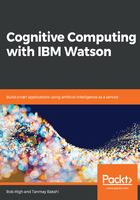
Summary
In this chapter, you learned about the Watson Assistant service. A good conversational agent is more than a single-turn, transactional response system. A conversation is about getting to the heart of the user's problem—keeping in mind that the first question someone asks is often not the question they really want to ask. Sometimes they don't even know what question to ask to solve their problem—they need to be walked through it. We've taught you the fundamentals of how to create a workspace in which you can train Watson to recognize the intents that your users might express, and to extract the entities within that expression. We also looked at how to build a dialog flow, in which you can guide the user through their conversation. We showed you how to jump around within that flow to address different ways that a user might proceed with their side of the conversation. Finally, we explained how to write a program in Python to make use of the service and from which you can drive the interaction with your end users.
In the next chapter, we will discuss Watson's Visual Recognition service, and how that can be used to classify different objects in a photograph or video image. We will elaborate on ways the Visual Recognition service can be used to characterize what it finds in those images.